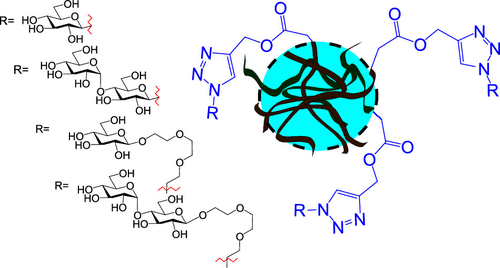当前位置:
X-MOL 学术
›
Biomacromolecules
›
论文详情
Our official English website, www.x-mol.net, welcomes your
feedback! (Note: you will need to create a separate account there.)
Glucose and Maltose Surface-Functionalized Thermoresponsive Poly(N-Vinylcaprolactam) Nanogels.
Biomacromolecules ( IF 5.5 ) Pub Date : 2020-01-22 , DOI: 10.1021/acs.biomac.9b01596 Joonas Siirilä 1 , Sami Hietala 1 , Filip S Ekholm 1 , Heikki Tenhu 1
Biomacromolecules ( IF 5.5 ) Pub Date : 2020-01-22 , DOI: 10.1021/acs.biomac.9b01596 Joonas Siirilä 1 , Sami Hietala 1 , Filip S Ekholm 1 , Heikki Tenhu 1
Affiliation

|
Soft nanoparticles are interesting materials due to their size, deformability, and ability to host guest molecules. Surface properties play an essential role in determining the fate of the particles in biological medium, and coating of the nanoparticles (and polymers) with carbohydrates has been found to be an efficient strategy for increasing their biocompatibility and fine-tuning other important properties such as aqueous solubility. In this work, soft nanogels of poly(N-vinylcaprolactam), PNVCL, were surface-functionalized with different glucose and maltose ligands, and the colloidal properties of the gels were analyzed. The PNVCL nanogels were first prepared via semibatch precipitation polymerization, where a comonomer, propargyl acrylate (PA), was added after preparticle formation. The aim was to synthesize "clickable" nanogels with alkyne groups on their surfaces. The nanogels were then functionalized with two separate azido-glucosides and azido-maltosides (containing different linkers) through a copper-catalyzed azide-alkyne cycloaddition (CuAAc) click reaction. The glucose and maltose bearing nanogels were thermoresponsive and shrank upon heating. Compared to the PNVCL-PA nanogel, the carbohydrate bearing ones were larger, more hydrophilic, had volume phase transitions at higher temperatures, and were more stable against salt-induced precipitation. In addition to investigating the colloidal properties of the nanogels, the carbohydrate recognition was addressed by studying the interactions with a model lectin, concanavalin A (Con A). The binding efficiency was not affected by the temperature, which indicates that the carbohydrate moieties are located on the gel surfaces, and are capable of interacting with other biomolecules independent of temperature. Thus, the synthesis produces nanogels, which have surface functions capable of biorelevant interactions and a thermoresponsive structure. These types of particles can be used for drug delivery.
中文翻译:

葡萄糖和麦芽糖表面功能化的热响应性聚(N-乙烯基己内酰胺)纳米凝胶。
软纳米颗粒由于其尺寸,可变形性和承载客体分子的能力而成为令人关注的材料。表面性质在决定生物介质中颗粒的命运方面起着至关重要的作用,并且发现用碳水化合物包被纳米颗粒(和聚合物)是增加其生物相容性和微调其他重要性质(例如水性)的有效策略。溶解度。在这项工作中,将聚(N-乙烯基己内酰胺)PNVCL纳米软凝胶用不同的葡萄糖和麦芽糖配体进行表面官能化,并分析了其胶体性质。PNVCL纳米凝胶首先通过半间歇沉淀聚合制备,其中在预颗粒形成后添加共聚单体丙烯酸丙烯酸炔丙酯(PA)。目的是合成“可点击” 在表面具有炔基的纳米凝胶。然后,通过铜催化的叠氮化物-炔烃环加成(CuAAc)点击反应,将纳米凝胶用两个单独的叠氮基葡糖苷和叠氮基麦芽糖苷(包含不同的接头)进行功能化。带有葡萄糖和麦芽糖的纳米凝胶具有热响应性,并在加热时收缩。与PNVCL-PA纳米凝胶相比,含碳水化合物的纳米凝胶更大,更亲水,在较高温度下具有体积相变,并且对盐诱导的沉淀更稳定。除了研究纳米凝胶的胶体性质外,还通过研究与模型凝集素伴刀豆球蛋白A(Con A)的相互作用来解决碳水化合物的识别问题。结合效率不受温度的影响,这表明碳水化合物部分位于凝胶表面上,并且能够独立于温度与其他生物分子相互作用。因此,合成产生纳米凝胶,其具有能够进行生物相关相互作用的表面功能和热响应性结构。这些类型的颗粒可用于药物递送。
更新日期:2020-01-23
中文翻译:

葡萄糖和麦芽糖表面功能化的热响应性聚(N-乙烯基己内酰胺)纳米凝胶。
软纳米颗粒由于其尺寸,可变形性和承载客体分子的能力而成为令人关注的材料。表面性质在决定生物介质中颗粒的命运方面起着至关重要的作用,并且发现用碳水化合物包被纳米颗粒(和聚合物)是增加其生物相容性和微调其他重要性质(例如水性)的有效策略。溶解度。在这项工作中,将聚(N-乙烯基己内酰胺)PNVCL纳米软凝胶用不同的葡萄糖和麦芽糖配体进行表面官能化,并分析了其胶体性质。PNVCL纳米凝胶首先通过半间歇沉淀聚合制备,其中在预颗粒形成后添加共聚单体丙烯酸丙烯酸炔丙酯(PA)。目的是合成“可点击” 在表面具有炔基的纳米凝胶。然后,通过铜催化的叠氮化物-炔烃环加成(CuAAc)点击反应,将纳米凝胶用两个单独的叠氮基葡糖苷和叠氮基麦芽糖苷(包含不同的接头)进行功能化。带有葡萄糖和麦芽糖的纳米凝胶具有热响应性,并在加热时收缩。与PNVCL-PA纳米凝胶相比,含碳水化合物的纳米凝胶更大,更亲水,在较高温度下具有体积相变,并且对盐诱导的沉淀更稳定。除了研究纳米凝胶的胶体性质外,还通过研究与模型凝集素伴刀豆球蛋白A(Con A)的相互作用来解决碳水化合物的识别问题。结合效率不受温度的影响,这表明碳水化合物部分位于凝胶表面上,并且能够独立于温度与其他生物分子相互作用。因此,合成产生纳米凝胶,其具有能够进行生物相关相互作用的表面功能和热响应性结构。这些类型的颗粒可用于药物递送。











































 京公网安备 11010802027423号
京公网安备 11010802027423号